Biodegradation of Pristine and Post-Consumer Extruded Expanded Polystyrene Packaging by Zophobas atratus Larvae: Influence of the Larval Stage and Physiological Response
Abstract
1. Introduction
2. Materials and Methods
2.1. Larvae and Their Diets
2.2. Biodegradation Experiments
2.3. Physicochemical Composition of Larvae
2.3.1. Total Moisture Content and Lipids
2.3.2. Analysis of the Fatty Acid Profile by Gas Chromatography
2.3.3. Analysis of Phenolic and Flavonoid Compounds
2.4. Characterization of the Diets and Frass
2.4.1. Scanning Electron Microscopy (SEM)
2.4.2. High Performance Size Exclusion Chromatography (HPSEC)
2.4.3. Fourier Transform Infrared Spectrometry with Attenuated Total Reflectance (FTIR-ATR)
2.4.4. Thermogravimetric Analysis (TGA)
2.4.5. Statistical Analysis
3. Results and Discussion
3.1. Physiological Response of Z. atratus Larvae
3.2. Physicochemical Composition of the Larvae
3.3. Characterization of Larval Frass
3.3.1. Scanning Electron Microscopy
3.3.2. High Performance Size Exclusion Chromatography
3.3.3. Fourier Transform Infrared Spectrometry with Attenuated Total Reflectance
3.3.4. Thermogravimetry
4. Conclusions
Supplementary Materials
Author Contributions
Funding
Institutional Review Board Statement
Data Availability Statement
Acknowledgments
Conflicts of Interest
References
- Abdulhay, H.S. Biodegradation of plastic wastes by confused flour beetle Tribolium confusum Jacquelin du Val larvae. Asian J. Agric. Biol. 2020, 8, 201–206. [Google Scholar] [CrossRef]
- Geyer, R. Production, use, and fate of synthetic polymers. In Plastic Waste and Recycling; Elsevier: Amsterdam, The Netherlands, 2020; pp. 13–32. [Google Scholar] [CrossRef]
- Kibria, M.G.; Masuk, N.I.; Safayet, R.; Nguyen, H.Q.; Mourshed, M. Plastic waste: Challenges and opportunities to mitigate pollution and effective management. Int. J. Environ. Res. 2023, 17, 20. [Google Scholar] [CrossRef]
- ABREMA. Panorama dos Resíduos Sólidos no Brasil; Associação Brasileira de Resíduos e Meio Ambiente: São Paulo, Brazil, 2024; Available online: https://www.abrema.org.br/panorama/ (accessed on 3 February 2025).
- Plastic Europe. Plastics—The Fast Facts, 2023. Plastic Europe. 2023. Available online: https://plasticseurope.org/knowledge-hub/plastics-the-fast-facts-2023/ (accessed on 5 March 2025).
- Song, Y.-K.; Hong, S.-H.; Eo, S.; Shim, W.J. The fragmentation of nano- and microplastic particles from thermoplastics accelerated by simulated-sunlight-mediated photooxidation. Environ. Pollut. 2022, 311, 119847. [Google Scholar] [CrossRef]
- Siddiqui, S.A.; Raza, W.; Kim, K.H.; Park, C. Polystyrene Microplastic Particles in the Food Chain: Accumulation, Uptake, and Ecotoxicological Effects. Sci. Total Environ. 2023, 880, 163746. [Google Scholar] [CrossRef]
- Castell-Rüdenhausen, M. Material flow analysis and modelling of the feedstock potential for recycling polystyrene. Circ. Econ. 2025, 4, 100127. [Google Scholar] [CrossRef]
- Yang, S.-S.; Brandon, A.M.; Andrew Flanagan, J.C.; Yang, J.; Ning, D.; Cai, S.-Y.; Fan, H.-Q.; Wang, Z.-Y.; Ren, J.; Benbow, E.; et al. Biodegradation of polystyrene wastes in yellow meal-worms (larvae of Tenebrio molitor Linnaeus): Factors affecting biodegradation rates and the ability of polystyrene-fed larvae to complete their life cycle. Chemosphere 2018, 191, 979–989. [Google Scholar] [CrossRef] [PubMed]
- Troya, M.D.C.; Power, O.-P.; Kopke, K. Is It All About the Data? How Extruded Polystyrene Escaped Single-Use Plastic Di-rective Market Restrictions. Front. Mar. Sci. 2022, 8, 817707. [Google Scholar] [CrossRef]
- Tian, Z.; Kim, S.-K.; Kim, K. Distinguishing between extractable and leachable contents of styrene oligomers in various poly-styrene consumer products: Towards environmentally realistic scenarios. J. Hazard. Mater. 2025, 487, 137190. [Google Scholar] [CrossRef] [PubMed]
- Jin, T.; Liu, Y.; Lyu, H.; He, Y.; Sun, H.; Tang, J.; Xing, B. Plastic takeaway food containers may cause human intestinal damage in routine life usage: Microplastics formation and cytotoxic effect. J. Hazard. Mater. 2024, 475, 134866. [Google Scholar] [CrossRef]
- Garcia, E.C.; Padula, M.; Souza, R.M.; Karaski, T.U. PS, XPS e EPS Para Contato com Alimentos; Plastivida: São Paulo, Brazil, 2017. [Google Scholar]
- Zhang, F.; Zhao, Y.; Wang, D.; Yan, M.; Zhang, J.; Zhang, P.; Ding, T.; Chen, L.; Chen, C. Current technologies for plastic waste treatment: A review. J. Clean. Prod. 2021, 282, 124523. [Google Scholar] [CrossRef]
- Muthukumar, J.; Kandukuri, V.A.; Chidambaram, R. A critical review on various treatment, conversion, and disposal ap-proaches of commonly used polystyrene. Polym. Bull. 2024, 81, 2819–2845. [Google Scholar] [CrossRef]
- Mumbach, G.D.; Bolzan, A.; Machado, R.A.F. A closed-loop process design for recycling expanded polystyrene waste by dissolution and polymerization. Polymers 2020, 209, 122940. [Google Scholar] [CrossRef]
- Junaid, M.; Liu, S.; Chen, G.; Liao, H.; Wang, J. Transgenerational impacts of micro(nano)plastics in the aquatic and terrestrial environment. J. Hazard. Mater. 2023, 443, 130274. [Google Scholar] [CrossRef]
- Elsamahy, T.; Sun, J.; Elsilk, S.E.; Ali, S.S. Biodegradation of low-density polyethylene plastic waste by a constructed tri-culture yeast consortium from wood-feeding termite: Degradation mechanism and pathway. J. Hazard. Mater. 2023, 448, 130944. [Google Scholar] [CrossRef]
- Khan, S.; Dong, Y.; Nadir, S.; Schaefer, D.A.; Mortimer, P.E.; Xu, J.; Ye, L.; Gui, H.; Wanasinghe, D.N.; Dossa, G.G.O.; et al. Valorizing plastic waste by insect consumption. J. Circ. Agric. Syst. 2021, 1, 1–9. [Google Scholar] [CrossRef]
- Niu, L.; Shen, J.; Li, Y.; Chen, Y.; Zhang, W.; Wang, L. Plastic additives alter the influence of photodegradation on biodegra-dation of polyethylene/polypropylene polymers in natural rivers. J. Hazard. Mater. 2025, 489, 137542. [Google Scholar] [CrossRef]
- Albright, V.C.; Chai, Y. Knowledge Gaps in Polymer Biodegradation Research. Environ. Sci. Technol. 2021, 55, 11476–11488. [Google Scholar] [CrossRef]
- Pivato, A.F.; Miranda, G.M.; Prichula, J.; Lima, J.A.; Ligabue, R.A.; Seixas, A.; Trentin, D.S. Hydrocarbon-based plastics: Pro-gress and perspectives on consumption and biodegradation by insect larvae. Chemosphere 2022, 293, 133600. [Google Scholar] [CrossRef] [PubMed]
- Li, J.-Y.; Yu, Y.; Craig, N.J.; He, W.; Su, L. Interactions between microplastics and insects in terrestrial ecosystems—A sys-tematic review and meta-analysis. J. Hazard. Mater. 2024, 462, 132783. [Google Scholar] [CrossRef]
- Rumbos, C.I.; Athanassiou, C.G. The Superworm, Zophobas morio (Coleoptera: Tenebrionidae): A ‘Sleeping Giant’ in Nutrient Sources. Insect Sci. 2021, 21, 13. [Google Scholar] [CrossRef] [PubMed]
- Nascimento, R.Q.; Ribeiro, C.V.M.; Colauto, N.B.; Silva, L.; Lemos, P.V.F.; Souza, E.F.; Linde, G.A.; Machado, B.A.S.; Tavares, P.P.; Biasoto, A.C.; et al. Utilization of Agro-Industrial Residues in the Rearing and Nutritional Enrichment of Zophobas atratus Larvae: New Food Raw Materials. Molecules 2022, 27, 6963. [Google Scholar] [CrossRef] [PubMed]
- Kuan, Z.-J.; Chan, B.K.-N.; Gan, S.K.-E. Worming the Circular Economy for Biowaste and Plastics: Hermetia illucens, Tenebrio molitor, and Zophobas morio. Sustainability 2022, 14, 1594. [Google Scholar] [CrossRef]
- Brandon, A.M.; Gao, S.H.; Tian, R.; Ning, D.; Yang, S.-S.; Zhou, J.; Wu, W.-M.; Criddle, C.S. Biodegradation of Polyethylene and Plastic Mixtures in Mealworms (Larvae of Tenebrio molitor) and Effects on the Gut Microbiome. Environ. Sci. Technol. 2018, 52, 6526–6533. [Google Scholar] [CrossRef] [PubMed]
- Peng, B.-Y.; Su, Y.; Chen, Z.; Chen, J.; Zhou, X.; Benbow, M.E.; Criddle, C.S.; Wu, W.-M.; Zhang, Y. Biodegradation of Poly-styrene by Dark (Tenebrio obscurus) and Yellow (Tenebrio molitor) Mealworms (Coleoptera: Tenebrionidae). Environ. Sci. Technol. 2019, 53, 5256–5265. [Google Scholar] [CrossRef] [PubMed]
- Yang, S.-S.; Ding, M.-Q.; He, L.; Zhang, C.-H.; Li, Q.-X.; Xing, D.-F.; Cao, G.-L.; Zhao, L.; Ding, J.; Ren, N.-Q.; et al. Biodegradation of polypropylene by yellow mealworms (Tenebrio molitor) and superworms (Zophobas atratus) via gut-microbe-dependent depolymerization. Sci. Total Environ. 2021, 756, 144087. [Google Scholar] [CrossRef]
- Bulak, P.; Proc, K.; Pytlak, A.; Puszka, A.; Gawdzik, B.; Bieganowski, A. Biodegradation of Different Types of Plastics by Tenebrio molitor Insect. Polymer 2021, 13, 3508. [Google Scholar] [CrossRef]
- He, L.; Yang, S.-S.; Ding, J.; He, Z.-L.; Pang, J.-W.; Xing, D.-F.; Zhao, L.; Zheng, H.-S.; Ren, N.-Q.; Wu, W.-M. Responses of gut microbiomes to commercial polyester polymer biodegradation in Tenebrio molitor Larvae. J. Hazard. Mater. 2023, 457, 131759. [Google Scholar] [CrossRef]
- Aboelkheir, M.; Visconte, L.Y.; Oliveira, G.E.; Toledo Filho, R.D.; Souza, F.G. The biodegradative effect of Tenebrio molitor Linnaeus larvae on vulcanized SBR and tire crumb. Sci. Total Environ. 2019, 649, 1075–1082. [Google Scholar] [CrossRef]
- Lou, Y.; Li, Y.; Lu, B.; Liu, Q.; Yang, S.-S.; Liu, B.; Ren, N.; Wu, W.-M.; Xing, D. Response of the yellow mealworm (Tenebrio molitor) gut microbiome to diet shifts during polystyrene and polyethylene biodegradation. Hazard. Mater. 2021, 416, 126222. [Google Scholar] [CrossRef]
- Wang, Y.; Zhao, X.; Wang, J.; Weng, Y.; Wang, Y.; Li, X.; Han, X. Ingestion preference and efficiencies of different polymeri-zation types foam plastics by Tenebrio molitor larvae, associated with changes of both core gut bacterial and fungal micro-biomes. Environ. Chem. Eng. 2023, 11, 110801. [Google Scholar] [CrossRef]
- Wang, Y.; Sun, H.; Wang, Z.; Wang, Y.; Li, X.; Han, X.; Zhao, X.; Zhou, A.; Wu, W.-M. Contribution of gut microbiota to biodegradation of polystyrene in Tenebrio molitor larvae: Microbiome under antibiotic suppression of Gram-positive, Gram-negative, and fungal microbes. Chem. Eng. J. 2024, 497, 154841. [Google Scholar] [CrossRef]
- Yang, Y.; Wang, J.; Xia, M. Biodegradation and mineralization of polystyrene by plastic-eating superworms Zophobas atratus. Sci. Total Environ. 2020, 708, 135233. [Google Scholar] [CrossRef] [PubMed]
- Peng, B.-Y.; Li, Y.; Fan, R.; Chen, Z.; Chen, J.; Brandon, A.M.; Criddle, C.S.; Zhang, Y.; Wu, W.-M. Biodegradation of low-density polyethylene and polystyrene in superworms, larvae of Zophobas atratus (Coleoptera: Tenebrionidae): Broad and limited extent depolymerization. Environ. Pollut. 2020, 266, 115206. [Google Scholar] [CrossRef]
- Jiang, S.; Su, T.; Zhao, J.; Wang, Z. Biodegradation of Polystyrene by Tenebrio molitor, Galleria mellonella, and Zophobas atratus Larvae and Comparison of Their Degradation Effects. Polymer 2021, 13, 3539. [Google Scholar] [CrossRef]
- Wang, Y.; Luo, L.; Li, X.; Wang, J.; Wang, H.; Chen, C.; Guo, H.; Han, T.; Zhou, A.; Zhao, X. Different plastics ingestion preferences and efficiencies of superworm (Zophobas atratus Fab.) and yellow mealworm (Tenebrio molitor Linn.) associated with distinct gut microbiome changes. Sci. Total Environ. 2022, 837, 155719. [Google Scholar] [CrossRef]
- Quan, Z.; Zhao, Z.; Liu, Z.; Wang, W.; Yao, S.; Liu, H.; Lin, X.; Li, Q.X.; Yan, H.; Liu, X. Biodegradation of polystyrene mi-croplastics by superworms (larve of Zophobas atratus): Gut microbiota transition, and putative metabolic ways. Chemosphere 2023, 343, 140246. [Google Scholar] [CrossRef] [PubMed]
- Peng, B.-Y.; Sun, Y.; Zhang, X.; Sun, J.; Xu, Y.; Xiao, S.; Chen, J.; Zhou, X.; Zhang, Y. Unveiling the residual plastics and produced toxicity during biodegradation of polyethylene (PE), polystyrene (PS), and polyvinyl chloride (PVC) microplastics by mealworms (Larvae of Tenebrio molitor). J. Hazard. Mater. 2023, 452, 131326. [Google Scholar] [CrossRef] [PubMed]
- Palmer, K.J.; Lauder, K.; Christopher, K.; Guerra, F.; Welch, R.; Bertuccio, A.J. Biodegradation of Expanded Polystyrene by Larval and Adult Stages of Tenebrio molitor with Varying Substrates and Beddings. Environ. Process. 2022, 9, 3. [Google Scholar] [CrossRef]
- Ding, M.-Q.; Ding, J.; Zhang, Z.-R.; Li, M.-X.; Cui, C.-H.; Pang, J.-W.; Xing, D.-F.; Ren, N.-Q.; Wu, W.-M.; Yang, S.-S. Bio-degradation of various grades of polyethylene microplastics by Tenebrio molitor and Tenebrio obscurus larvae: Effects on their physiology. Environ. Manag. 2024, 358, 120832. [Google Scholar] [CrossRef]
- AOAC International. AOAC—Official Methods of Analysis; AOAC International: Rockville, MD, USA, 2005. [Google Scholar]
- Bligh, E.G.; Dyer, W.J. A rapid method of total lipid extraction and purification. Can. J. Biochem. Physiol. 1959, 37, 911–917. [Google Scholar] [CrossRef]
- Souza, C.O.; Leite, M.E.Q.; Lasekan, J.; Baggs, G.; Pinho, L.S.; Druzian, J.I.; Ribeiro, T.C.M.; Mattos, Â.P.; Menezes-Filho, J.A.; Costa-Ribeiro, H. Milk protein-based formulas containing different oils affect fatty acids balance in term infants: A ran-domized blinded crossover clinical trial. Lipid. Health Dis. 2017, 16, 78. [Google Scholar] [CrossRef]
- Singleton, V.L.; Rossi, J.A. Colorimetry of Total Phenolics with Phosphomolybdic-Phosphotungstic Acid Reagents. Am. J. Enol. Vitic. 1965, 16, 144–158. [Google Scholar] [CrossRef]
- Lee, H.S.; Kim, J.G. Effects of debittering on red grapefruit juice concentrate. Food Chem. 2003, 82, 177–180. [Google Scholar] [CrossRef]
- Peng, B.-Y.; Xu, Y.; Sun, Y.; Xiao, S.; Sun, J.; Shen, Z.; Chen, J.; Zhou, X.; Zhang, Y. Biodegradation of polyethylene (PE) microplastics by mealworm larvae: Physiological responses, oxidative stress, and residual plastic particles. J. Clean. Prod. 2023, 402, 136831. [Google Scholar] [CrossRef]
- Sun, D.; Zhang, B.; Zhou, C.; Wang, B.; Wu, M. Study on high moisture extruded pea protein isolate based on acid-induced process: Physicochemical properties, conformational changes and fibrous structure mechanism. Food Hydrocoll. 2023, 141, 108746. [Google Scholar] [CrossRef]
- Payanthoth, N.S.; Mut, N.N.; Samanta, P.; Li, G.; Jung, J. A review of biodegradation and formation of biodegradable microplastics in soil and freshwater environments. Appl. Biol. Chem. 2024, 67, 110. [Google Scholar] [CrossRef]
- Bożek, M.; Hanus-Lorenz, B.; Rybak, J. The studies on waste biodegradation by Tenebrio molitor. E3S Web Conf. 2017, 17, 00011. [Google Scholar] [CrossRef]
- Liu, Y.; Shen, N.; Xin, H.; Yu, L.; Xu, Q.; Cui, Y. Unsaturated fatty acids in natural edible resources, a systematic review of classification, resources, biosynthesis, biological activities and application. J. Food Biosci. 2023, 53, 102790. [Google Scholar] [CrossRef]
- Ding, M.-Q.; Ding, J.; Yang, S.S.; Ren, X.R.; Shi, S.N.; Zhang, L.Y.; Xing, D.F.; Ren, N.Q.; Wu, W.M. Effects of plastic aging on biodegradation of polystyrene by Tenebrio molitor larvae: Insights into gut microbiome and bacterial metabolism. Sci. Total. Environ. 2024, 953, 176130. [Google Scholar] [CrossRef]
- Zhong, Z.; Zhou, X.; Xie, Y.; Chu, L.M. The interplay of larval age and particle size regulates micro-polystyrene biodegradation and development of Tenebrio molitor L. Sci. Total Environ. 2023, 857 Pt 2, 159335. [Google Scholar] [CrossRef]
- Fang, J.; Xuan, Y.; Li, Q. Preparation of polystyrene spheres in different particle sizes and assembly of the PS colloidal crys-tals. China Technol. Sci. 2010, 53, 3088–3093. [Google Scholar] [CrossRef]
- Luo, L.; Wang, Y.; Guo, H.; Yang, Y.; Qi, N.; Zhao, X.; Gao, S.; Zhou, A. Biodegradation of foam plastics by Zophobas atratus larvae (Coleoptera: Tenebrionidae) associated with changes of gut digestive enzymes activities and microbiome. Chemosphere 2021, 282, 131006. [Google Scholar] [CrossRef]
- Wang, S.; Yu, H.; Li, W.; Song, E.; Zhao, Z.; Xu, J.; Gao, S.; Wang, D.; Xie, Z. Biodegradation of four polyolefin plastics in superworms (Larvae of Zophobas atratus) and effects on the gut microbiome. J. Hazard. Mater. 2024, 477, 135381. [Google Scholar] [CrossRef]
- Majder-Łopatka, M.; Węsierski, T.; Ankowski, A.; Ratajczak, K.; Duralski, D.; Piechota-Polanczyk, A.; Polanczyk, A. Thermal Analysis of Plastics Used in the Food Industry. Materials 2021, 15, 248. [Google Scholar] [CrossRef]
- Veroneze, I.B.; Onoue, L.A.; Cruz, S.A. Thermal Stability and Crystallization Behavior of Contaminated Recycled Polypropylene for Food Contact. Environ. Polym. Degrad. 2022, 30, 3474–3482. [Google Scholar] [CrossRef]
- Arun, M.; Bigger, S.; Guerrieri, M.; Joseph, P.; Tretsiakova-McNally, S. Thermal and Calorimetric Investigations of Some Phosphorus-Modified Chain Growth Polymers 2: Polystyrene. Polymers 2022, 14, 1520. [Google Scholar] [CrossRef] [PubMed]
- Kim, H.R.; Lee, H.M.; Yu, H.C.; Jeon, E.; Lee, S.; Li, J.; Kim, D.H. Biodegradation of Polystyrene by Pseudomonas sp. Isolated from the Gut of Superworms (Larvae of Zophobas atratus). Environ. Sci. Technol. 2020, 54, 6987–6996. [Google Scholar] [CrossRef] [PubMed]
- Zaman, I.; Rahman, M.; Yasir, M.; Al-Turki, A.I.; Iqbal, H.M.N.; Hashmi, M.Z. Biodegradation of Polyethylene and Polystyrene by Zophobas atratus Larvae: Isolation and Whole-Genome Sequencing of Gut Bacteria. Environ. Pollut. 2024, 345, 123446. [Google Scholar] [CrossRef] [PubMed]
- Vital-Vilchis, I.; Karunakaran, E. Using Insect Larvae and Their Microbiota for Plastic Degradation. Insects 2025, 16, 165. [Google Scholar] [CrossRef]
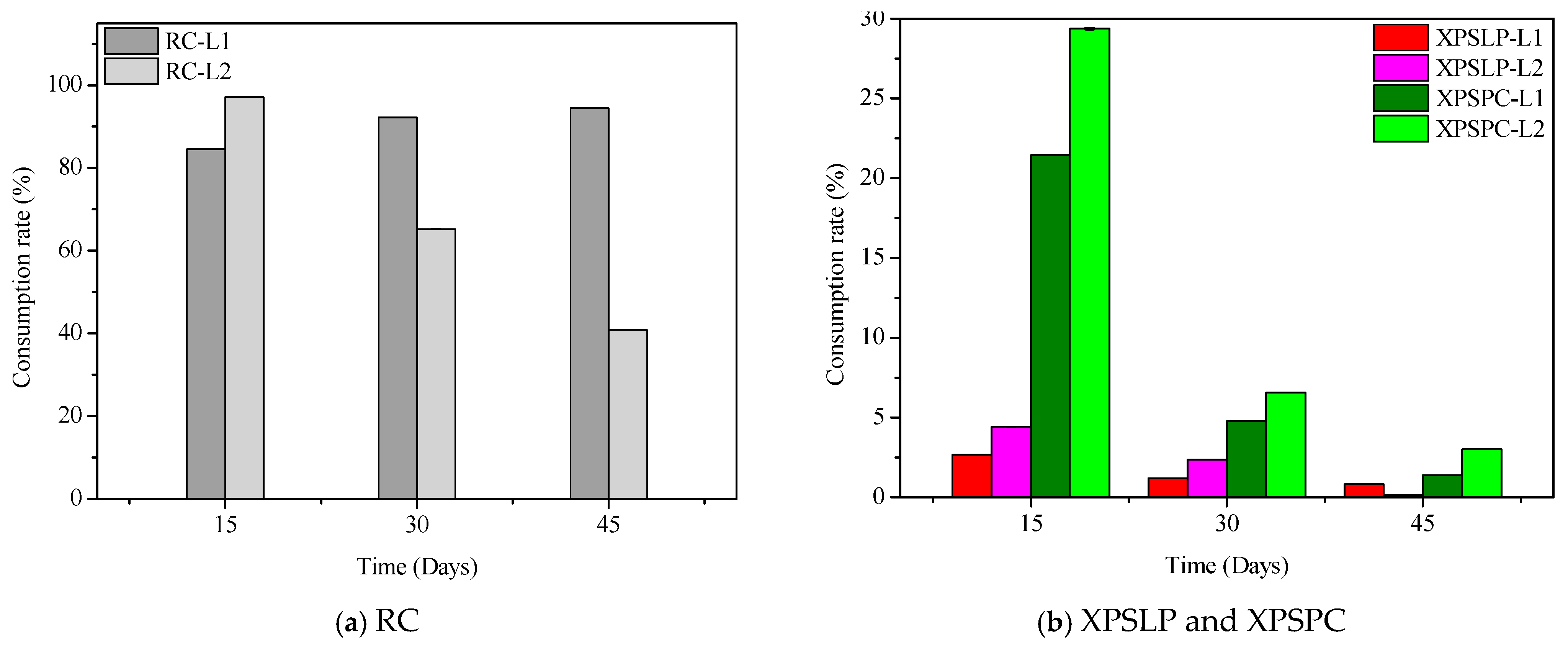
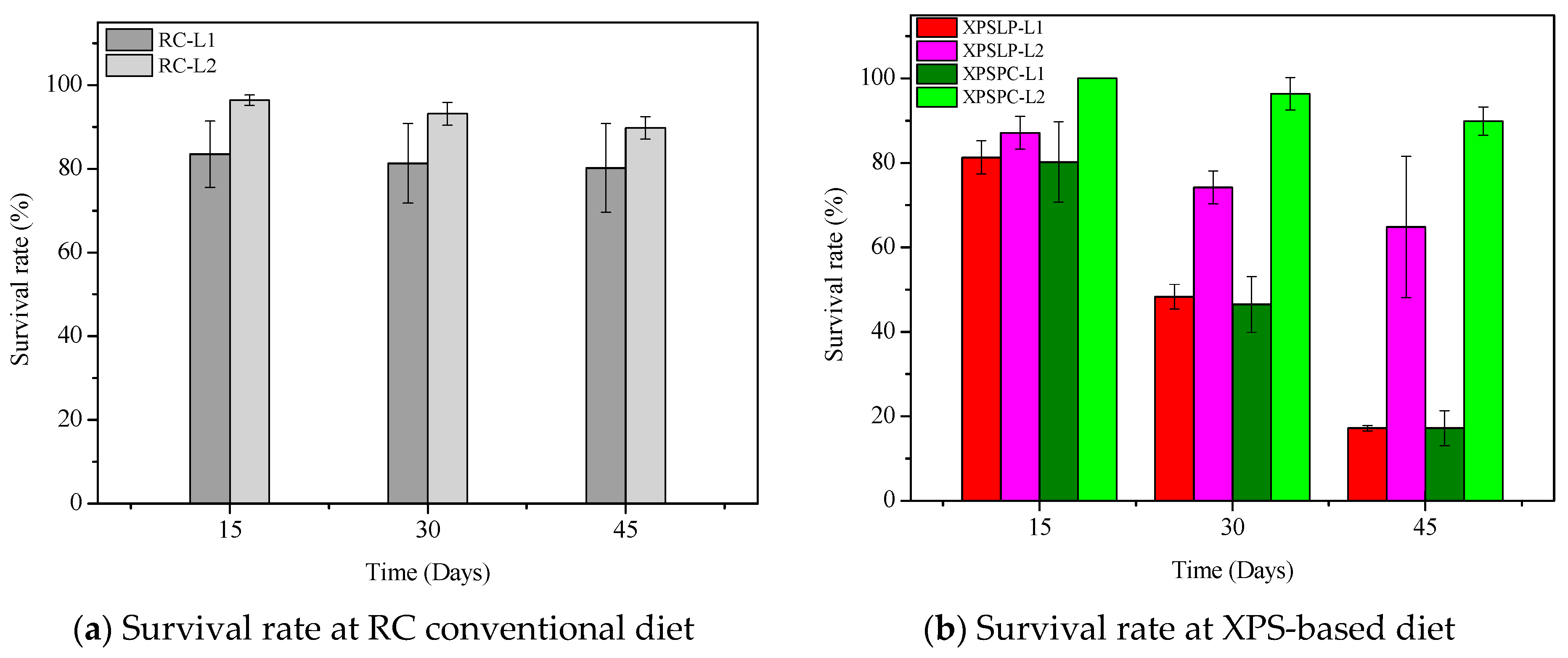
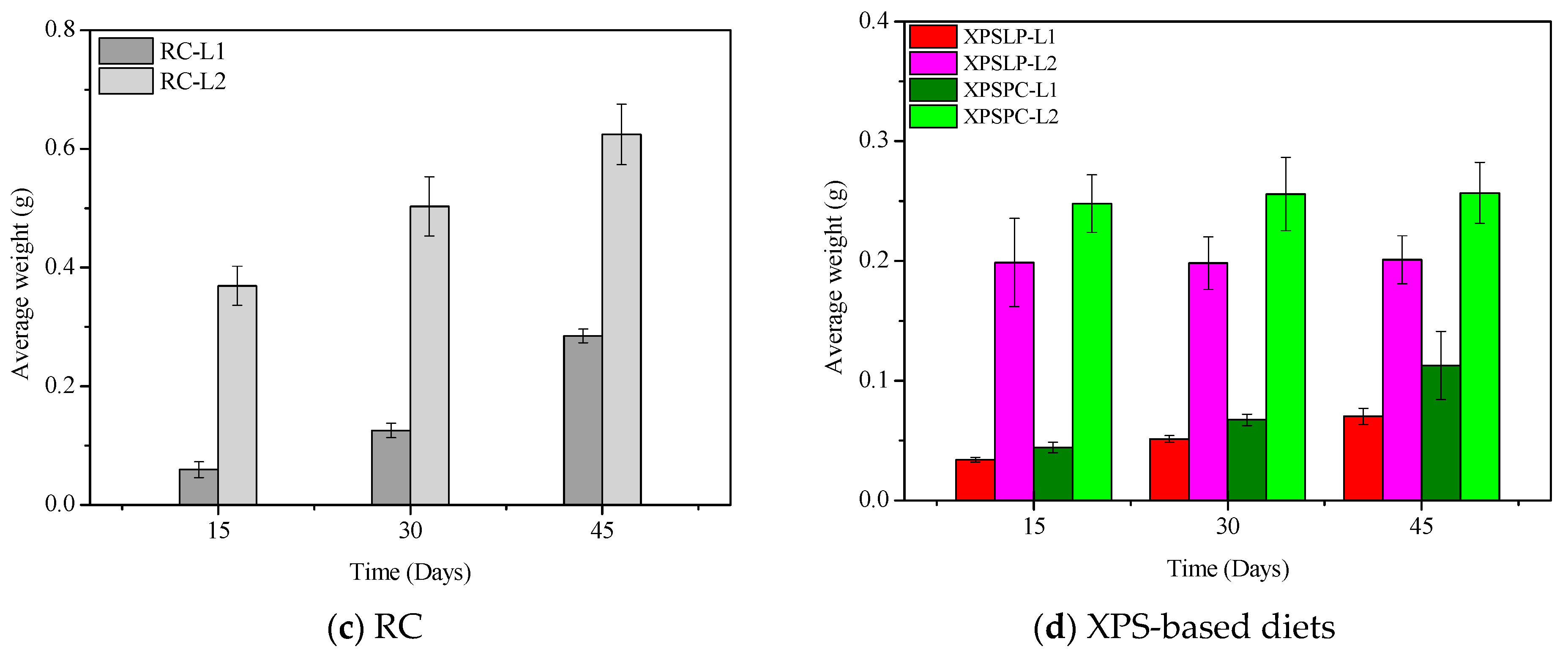
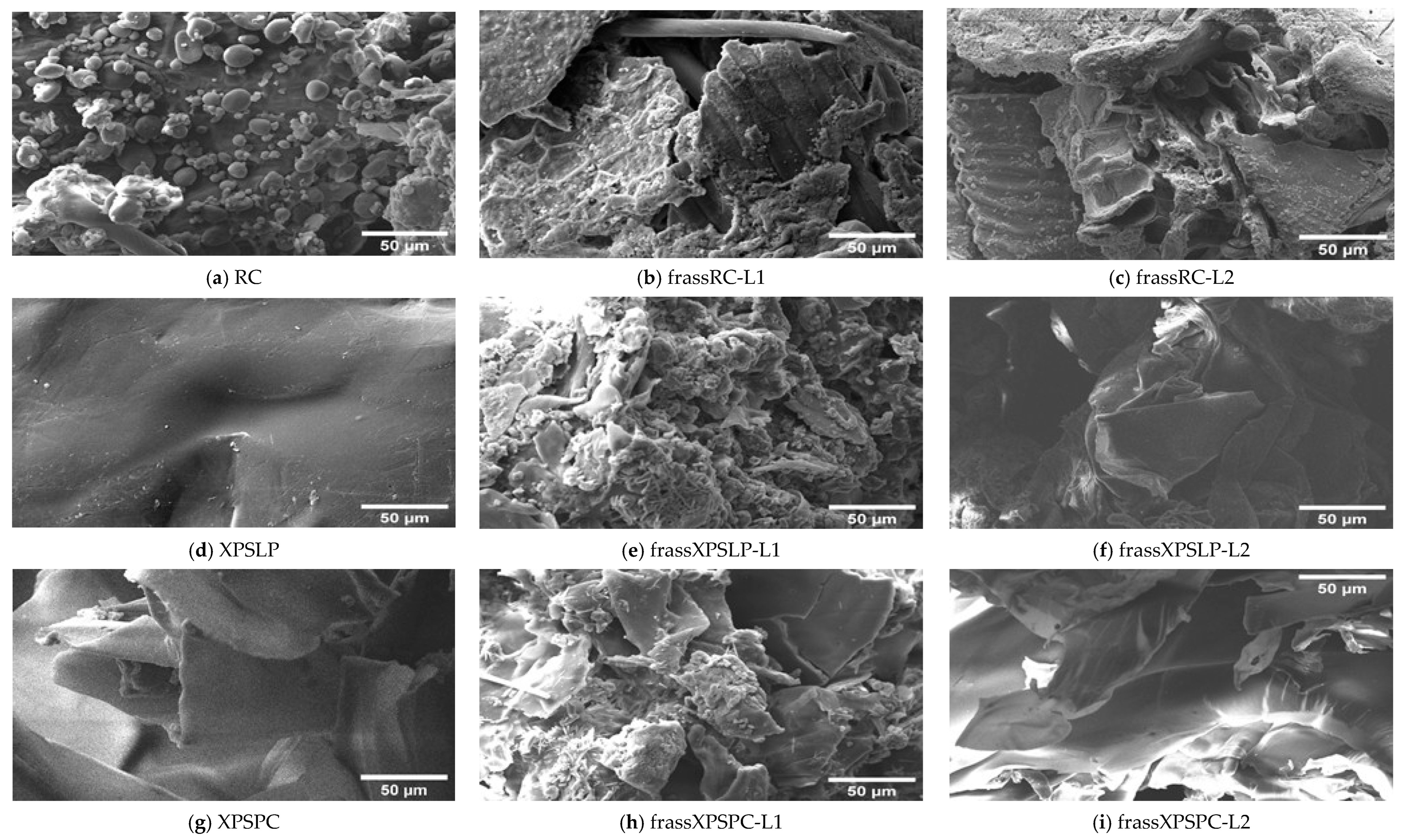
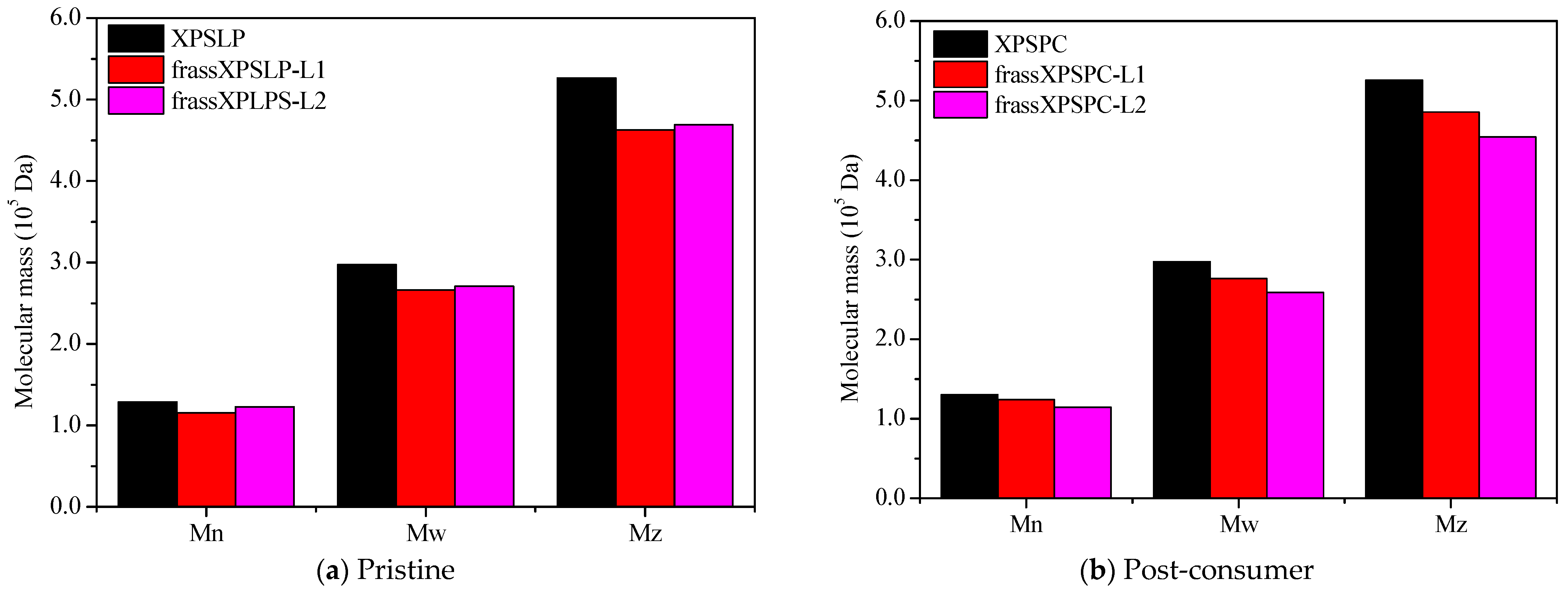
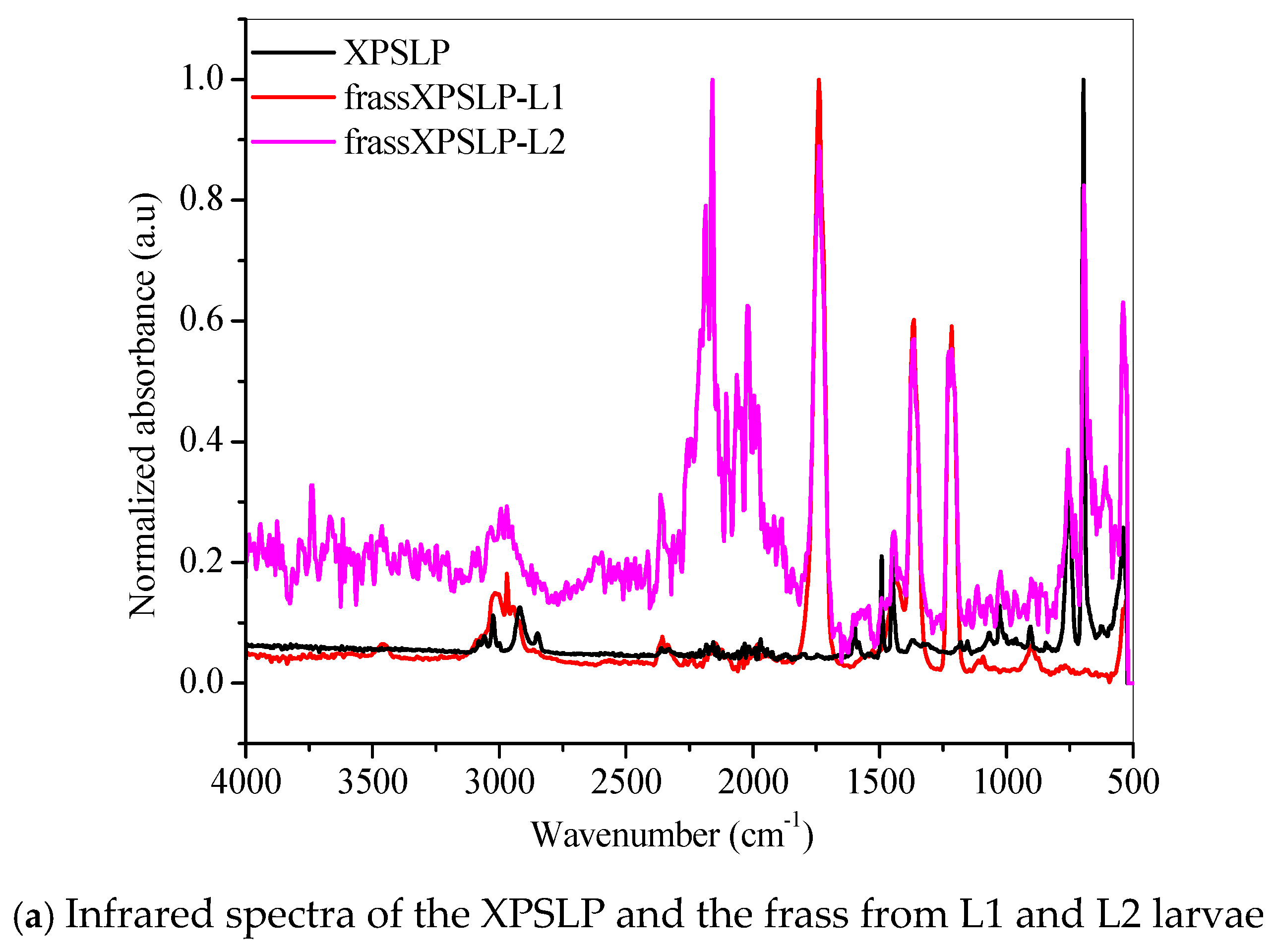
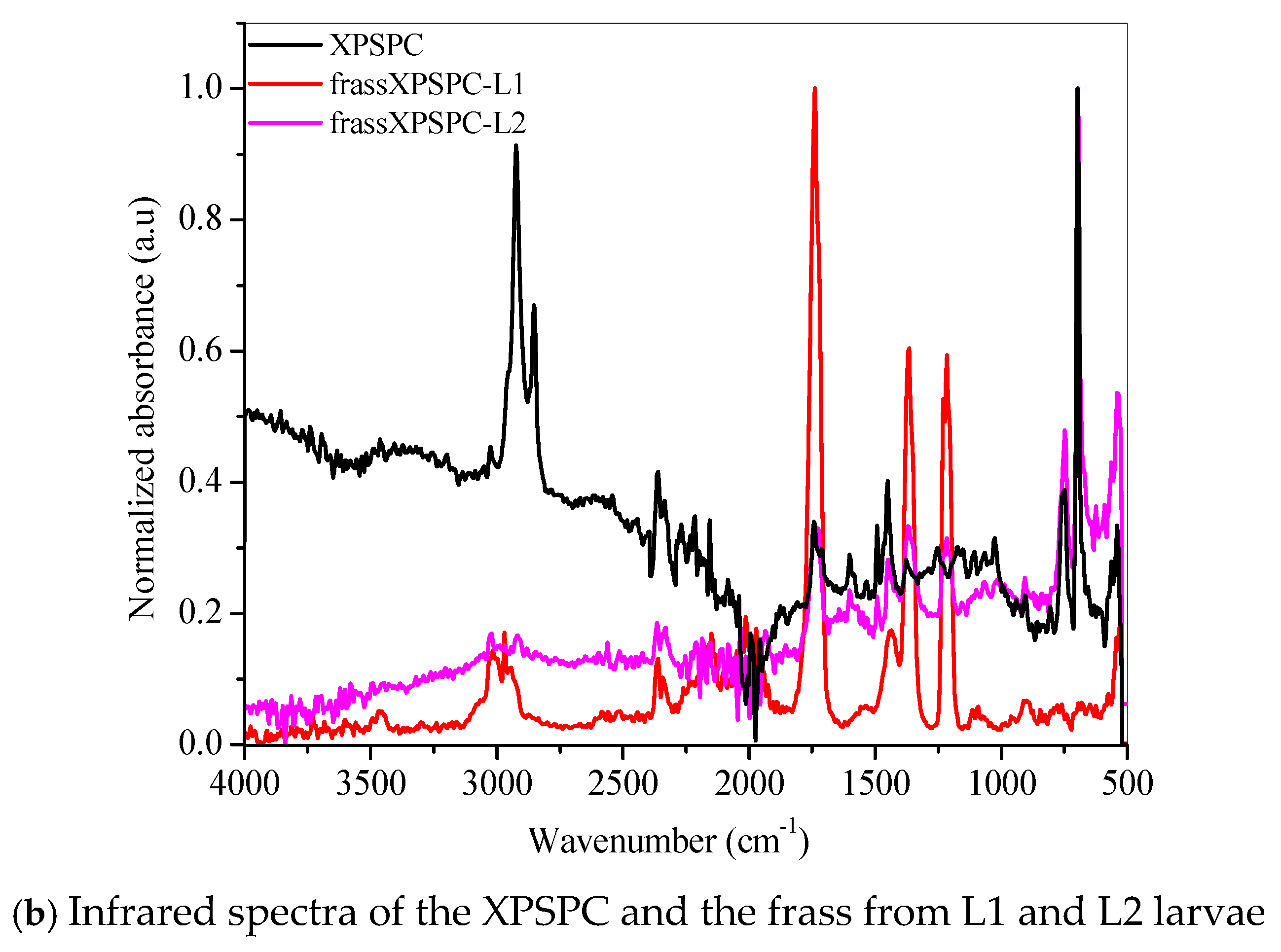

| Sample Code | Description |
|---|---|
| RC | Control sample of commercial diet |
| RC-L1 | Larvae of group L1 fed with commercial feed only |
| RC-L2 | Larvae of group L1 fed with commercial feed only |
| frassRC-L1 | Frass of larvae of group L1 fed with commercial feed only |
| frassRC-L2 | Frass of larvae of group L2 fed with commercial feed only |
| XPSLP | Control sample of pristine XPS packages |
| XPSLP-L1 | Larvae of group L1 were fed with pristine XPS feed only |
| XPSLP-L2 | Larvae of group L1 were fed with pristine XPS feed only |
| frassXPSLP-L1 | Frass of larvae of group L1 were fed with pristine XPS feed only |
| frassXPSLP-L2 | Frass of larvae of group L2 were fed with pristine XPS feed only |
| XPSPC | Control sample of post-consumer XPS packages |
| XPSPC-L1 | Larvae of group L1 fed with post-consumer XPS feed only |
| XPSPC-L2 | Larvae of group L2 fed with post-consumer XPS feed only |
| frassXPSPC-L1 | Frass of larvae of group L1 fed with post-consumer XPS feed only |
| frassXPSPC-L2 | Frass of larvae of group L2 fed with post-consumer XPS feed only |
| Diet | Moisture (%) | Lipids (%) | C16:0 | C18:0 | C18:1 ω-9 | C18:2 ω-6 | Phenolics (mg/100g) | Flavonoids (mg/100g) |
|---|---|---|---|---|---|---|---|---|
| RC-L2 | 56.23 ± 1.15 | 15.30 ± 0.67 | 37.11 ± 1.31 | 8.16 ± 0.21 | 30.61 ± 0.69 | 22.25 ± 0.69 | 3.26 ± 0.53 | 0.012 ± 0.006 |
| XPSLP-L2 | 67.77 ± 13.30 | 3.47 ± 0.48 | 33.44 ± 0.24 | 10.37 ± 0.09 | 31.82 ± 0.17 | 22.25 ± 0.02 | 5.59 ± 0.47 | 0.040 ± 0.008 |
| XPSPC-L2 | 78.12 ± 0.58 | 2.96 ± 0.75 | 33.53 ± 0.23 | 10.31 ± 0.40 | 33.31 ± 0.23 | 20.79 ± 0.29 | 1.72 ± 0.07 | 0.041 ± 0.019 |
Disclaimer/Publisher’s Note: The statements, opinions and data contained in all publications are solely those of the individual author(s) and contributor(s) and not of MDPI and/or the editor(s). MDPI and/or the editor(s) disclaim responsibility for any injury to people or property resulting from any ideas, methods, instructions or products referred to in the content. |
© 2025 by the authors. Licensee MDPI, Basel, Switzerland. This article is an open access article distributed under the terms and conditions of the Creative Commons Attribution (CC BY) license (https://creativecommons.org/licenses/by/4.0/).
Share and Cite
Pereira, J.D.; Santana, J.S.; Lemos, P.V.F.; Assis, D.d.J.; Souza, C.O.d.; Cardoso, L.G.; Lucas, A.A.; Gonçalves, L.M.G.; Sebastião, R.d.C.d.O.; Ferreira, B.D.d.L.; et al. Biodegradation of Pristine and Post-Consumer Extruded Expanded Polystyrene Packaging by Zophobas atratus Larvae: Influence of the Larval Stage and Physiological Response. Polymers 2025, 17, 2870. https://doi.org/10.3390/polym17212870
Pereira JD, Santana JS, Lemos PVF, Assis DdJ, Souza COd, Cardoso LG, Lucas AA, Gonçalves LMG, Sebastião RdCdO, Ferreira BDdL, et al. Biodegradation of Pristine and Post-Consumer Extruded Expanded Polystyrene Packaging by Zophobas atratus Larvae: Influence of the Larval Stage and Physiological Response. Polymers. 2025; 17(21):2870. https://doi.org/10.3390/polym17212870
Chicago/Turabian StylePereira, Juraci Duarte, Jamille Santos Santana, Paulo Vitor França Lemos, Denilson de Jesus Assis, Carolina Oliveira de Souza, Lucas Guimarães Cardoso, Alessandra Almeida Lucas, Lívia Maria Garcia Gonçalves, Rita de Cássia de Oliveira Sebastião, Bárbara Darós de Lelis Ferreira, and et al. 2025. "Biodegradation of Pristine and Post-Consumer Extruded Expanded Polystyrene Packaging by Zophobas atratus Larvae: Influence of the Larval Stage and Physiological Response" Polymers 17, no. 21: 2870. https://doi.org/10.3390/polym17212870
APA StylePereira, J. D., Santana, J. S., Lemos, P. V. F., Assis, D. d. J., Souza, C. O. d., Cardoso, L. G., Lucas, A. A., Gonçalves, L. M. G., Sebastião, R. d. C. d. O., Ferreira, B. D. d. L., Marques, M. B. d. F., Rocha, A. R., Nascimento, R. Q., & Silva, J. B. A. d. (2025). Biodegradation of Pristine and Post-Consumer Extruded Expanded Polystyrene Packaging by Zophobas atratus Larvae: Influence of the Larval Stage and Physiological Response. Polymers, 17(21), 2870. https://doi.org/10.3390/polym17212870








